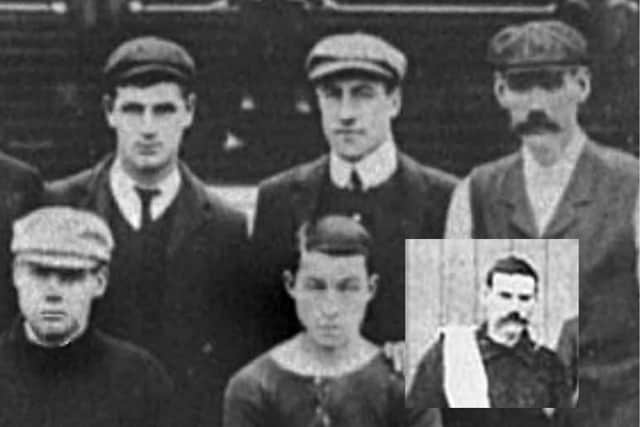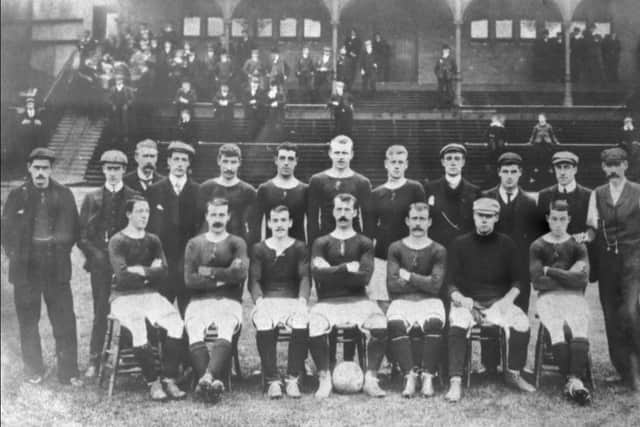Cocoa, dominos, and long walks to Portobello: How Paddy Cannon primed Hibs for league and cup success in 1900s


It seemed as though the club was finally beginning to recover from the emergence of Celtic; the subsequent loss of many of their players to the newly-established Glasgow club, and the temporary suspension of operations in 1891.
In 1896 one Paddy Cannon was appointed groundsman, marking the start of a long and fruitful relationship between man and club, but it can’t have been known at the time of his appointment the key role he would later play in one of the club’s most successful periods.
Farm-reared running machine


Advertisement
Hide AdAdvertisement
Hide AdBorn to Irish immigrant parents Peter and Bridget in January 1857, Cannon grew up helping on his parents’ farm in the shadow of Stirling Castle, sowing the seeds for his future career.
As a young man his focus had been on running. A latecomer to athletics, he was in his twenties before he began competing, travelling the length and breadth of the country to take part in races and Highland Games.
Information is unfortunately scant but newspaper reports of the time refer to his astonishing pattern of success in two and three-mile distance races.
When he wasn’t competing, Cannon – who shunned cigarettes and alcohol – continued working on the farm and in sawmills during winter. The manual labour kept him physically fit despite no tailored athletics training.
Advertisement
Hide AdAdvertisement
Hide AdBy the mid-1880s, he had started competing regularly in England. He travelled to Dublin, and Paris, participating in races in both cities and by the end of 1888 he had set two professional world records in running for the three-mile and four-mile races in a six-month period.
A leg injury forced the rescheduling of a planned trip to the USA and although he eventually crossed the pond and gave a good account of himself, he struggled to match the Americans for pace.
Stint with Glasgow Hibernians
It was around this time that Cannon had a stint as trainer for Glasgow Hibernian FC; a short-lived breakaway team from Celtic between 1889 and 1890. It is impossible to say if the experience whetted his appetite for involvement in football but six years later, with his athletics career on the wane as he approached his fortieth birthday, Cannon accepted a job as groundsman for Hibs and moved his young family to Lyne Street in Abbeyhill.
His experience at his parents’ farm was the perfect precursor to looking after the Easter Road pitch but after barely 12 months in the club’s employ he was promoted to a joint trainer-groundsman role. It would prove to be a shrewd move by the club’s hierarchy.
Advertisement
Hide AdAdvertisement
Hide AdCannon had assisted other runners with rehabilitation after injury and his training methods were ahead of their time. Players were put through their paces by the Stirling-born trainer, who commanded a great respect from the relatively young squad as he fashioned a regime that focused on long-term health and benefits.
Under the tutelage of club secretary Dan McMichael and with Cannon keeping the team in tip-top condition, Hibs reached the final of the Scottish Cup in 1902.
The Capital club had seen off Clyde in the first round; beaten Port Glasgow Athletic in the second round, and thrashed Queen’s Park 7-1 in the quarter-finals.
After a 2-0 win over Rangers in the semi-final, Hibs set up a showpiece final against Celtic. The match had been scheduled to take place at Rangers’ ground on April 12 but the 1902 Ibrox disaster the week before led to a change of venue, to Celtic Park, and the fixture being pushed back until April 26.
Cup final preparations
Advertisement
Hide AdAdvertisement
Hide AdThe week before the final, Cannon upped his preparations. Players undertook long walks to Portobello, presumably from the stadium; a trip of just under three miles.
Evenings were spent playing dominos to build team spirit, and the squad was fed thick-cut potted-heid sandwiches and mugs of cocoa.
Cannon’s approach worked wonders as Hibs edged a 1-0 win in the final thanks to Andy McGeachan’s goal 15 minutes from time. The team then went on to win the league championship the following season, holding the league trophy and Scottish Cup in early 1903.
Cannon’s work on the turf won him plaudits, and an Edinburgh Evening News article of the time stated: “The Hibernian ground never looks quite so well as it is doing at present, a prettier sheet of turf being found nowhere.
Advertisement
Hide AdAdvertisement
Hide Ad“It reflects credit on Cannon, the trainer and groundsman, who, with the secretary has been busy of recent weeks improving in little ways the players’ quarters, the idea apparently being to enable both home and visiting teams to make their entrance to the field from the right corner hitherto sacred to the home players.
“This will be a minor but by no means unimportant improvement.”
Cannon was awarded a benefit match against Rangers in 1912 but remained with the team until 1939, although his duties altered somewhat in his advancing years.
Still running… at 61
Despite his age, he got his running shoes back on in 1919 to take part in the Powderhall Marathon. The 61-year-old ran alongside his son Tom and given a nine-lap start, he led for half of the distance before being overtaken and eventually finishing a respectable fifth.
Advertisement
Hide AdAdvertisement
Hide AdWhile more hands-on trainers were appointed – including son Tom in 1930 – Cannon senior remained at the club as groundsman and according to the Evening News of February 1 1933, “his [training] advice is often sought and willingly given”.
Paddy eventually retired in June 1939 aged 83 but when Tom was called up to the Auxiliary Fire Service during the war, took on his son’s duties.
He was often seen at Easter Road in his later years and retained a keen interest in both football and athletics until he passed away at Edinburgh’s City Hospital in August 1946 at the age of 89.
A message from the Editor:
Thank you for reading this article. We’re more reliant on your support than ever as the shift in consumer habits brought about by Coronavirus impacts our advertisers.
If you haven’t already, please consider supporting our sports coverage with a digital sports subscription.
Comment Guidelines
National World encourages reader discussion on our stories. User feedback, insights and back-and-forth exchanges add a rich layer of context to reporting. Please review our Community Guidelines before commenting.